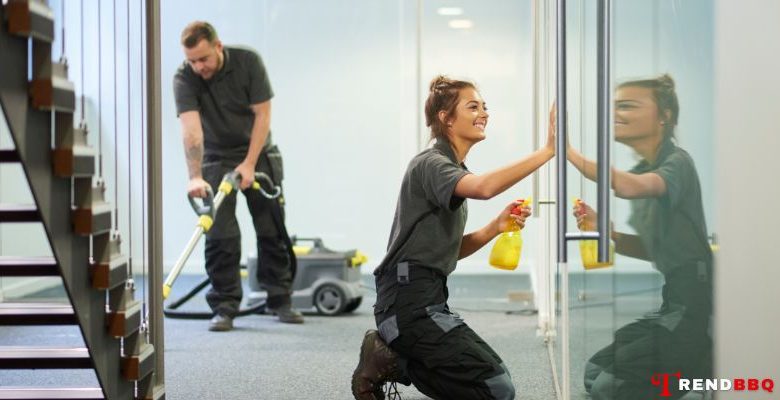
Mould is a common problem that can affect many surfaces in your home, such as walls, ceilings, tiles, carpets, and fabrics. Mould can cause health issues, such as allergies, asthma, and infections, as well as damage your property and belongings. Therefore, it is important to know how to get rid of mould and prevent it from coming back. In this article, Trendbbq will explain what mould is, what causes it, how to get rid of mold from different surfaces, and how to prevent it in the future.
Table of Contents,
1. What is Mould and What Causes It?
Mold, which is a form of fungus, develops through multicellular filaments called hyphae. It is a common natural organism that plays a crucial role in breaking down dead organic matter and recycling nutrients in the environment. However, mold can become a problem when it grows indoors, as it can cause health issues and damage to structures and materials.
Causes of Mold Growth:
Mold requires certain conditions to grow and thrive. The main factors that contribute to mold growth indoors include:
- Moisture: Mold thrives in damp environments. Excess moisture from sources like leaks, water damage, high humidity, or poor ventilation can create conditions suitable for mold growth.
- Organic Material: Mold feeds on organic materials such as wood, paper, fabric, and dust. These materials are commonly found indoors, providing a food source for mold.
- Warmth: Optimal temperature for mold growth falls within the range of 77°F (25°C) to 86°F (30°C). However, it can grow in a wider range of temperatures.
- Poor Ventilation: Inadequate ventilation can lead to stagnant air and moisture buildup, creating an environment conducive to mold growth.
- Darkness: While mold can grow in light, it thrives in dark and poorly lit areas.
- Humidity: High humidity levels encourage mold growth. Indoor humidity should ideally be kept below 50% to prevent mold problems.
- Condensation: Condensation can occur on cold surfaces when warm, humid air comes into contact with them. This can generate a damp setting conducive to the growth of mold.
- Water Intrusion: Leaks from pipes, roofs, windows, or other structural elements can introduce moisture into the indoor environment, promoting mold growth.
- Poor Building Design: Structures with poor design that trap moisture or inhibit proper airflow can lead to mold problems.
2. How to get rid of mold from Different Surfaces
Getting rid of mold from different surfaces requires specific cleaning methods and products tailored to each surface type. Here’s how to remove mold from various surfaces:
Hard Surfaces (Tiles, Glass, Metal)
- Mix equal parts of water and white vinegar or hydrogen peroxide in a spray bottle.
- Spray the solution onto the moldy surface and let it sit for about 10-15 minutes.
- Scrub the area with a scrub brush or cloth to remove the mold.
- Rinse the surface with clean water and wipe it dry.
Wood Surfaces
- Mix a solution of water and mild detergent (or dish soap).
- Use a cloth or soft brush to scrub the moldy area gently.
- Rinse with clean water and dry the surface thoroughly.
- If the mold persists, consider using a mixture of water and white vinegar, or hydrogen peroxide (for non-colored wood surfaces).
Fabrics and Upholstery
- For washable fabrics, remove the item and wash it in hot water with detergent. Add a cup of white vinegar to the wash to help eliminate mold.
- For non-washable items, brush off any loose mold outdoors. Use a fabric-safe mold remover according to the product’s instructions.
Carpet
- Vacuum the area thoroughly to remove loose mold.
- Use a mixture of water and mild detergent to clean the affected area.
- Dab the region using a fresh cloth to eliminate any extra moisture.
- Use a carpet cleaner or an upholstery cleaner if needed, following the manufacturer’s instructions.
Ceilings and Walls
- Mix water and mild detergent, or use a commercial mold remover.
- Scrub the area gently with a brush or cloth.
- For painted surfaces, avoid using abrasive materials that could damage the paint.
- Rinse with clean water and dry the area completely.
Porous Surfaces (Drywall, Wallpaper, Ceiling Tiles)
Porous surfaces can be challenging to clean thoroughly. If the mold growth is severe, it’s often best to replace the affected material to prevent further contamination.
How to remove mould in Bathroom Surfaces (Tiles, Grout, Shower Curtains)
- Mix equal parts of water and white vinegar in a spray bottle.
- Spray the solution onto the moldy surfaces, especially in grout lines.
- Scrub with a brush or cloth.
- Rinse with water and dry the area.
Outdoor Surfaces (Concrete, Patio Furniture, Walls)
- Use a mixture of water and bleach (1 part bleach to 10 parts water) on non-porous outdoor surfaces.
- Scrub the area with a brush and rinse well.
- Wear protective gear and ensure proper ventilation when working with bleach.
3. How to Prevent Mould in Your Home
To effectively prevent mold growth in your home, it’s crucial to manage moisture and humidity levels. Implement these strategies to maintain a dry and mold-free environment:
- Ensure proper ventilation: Regularly open windows and doors to facilitate fresh air circulation. Employ exhaust fans or dehumidifiers in moisture-prone spots like the bathroom, kitchen, and basement. Keep fan and dehumidifier filters clean and replace them as needed.
- Address leaks and water damage: Inspect pipes, faucets, roofs, and walls for signs of leaks or water damage. Swiftly repair any leaks or cracks. Dry damp areas within 24 to 48 hours to hinder mold development.
- Manage spills and floods: Address spills and floods promptly by cleaning and drying affected areas. Utilize towels, mops, or wet vacuums to remove excess water. Deploy fans, heaters, or dehumidifiers to ensure thorough drying.
- Properly store belongings: Avoid storing moisture-retaining items such as clothes, books, or papers in damp spaces like the basement or attic. Opt for sealed plastic containers or bags. Ensure clothes and fabrics are thoroughly washed and dried prior to storage. Dispose of items damaged by mold.
Mould is a common problem that can affect many surfaces in your home and cause health issues and property damage. However, you can get rid of mould and prevent it from coming back by following the how to get rid of mold in this article. Remember to wear protective gear when cleaning mould, use appropriate products for different surfaces, scrub the surface well, rinse and dry it thoroughly, and dispose of contaminated materials. To prevent mould in your home, ventilate your home regularly, fix leaks and water damage, clean and dry spills and floods, and store items properly. By doing these steps, you can keep your home healthy and mould-free.
4. FAQs
What is mold, and why is it important to remove it?
Mold is a type of fungus that can grow in damp and humid environments. It’s important to remove mold as it can cause health issues and damage to surfaces in your home.
How to get rid of mold in my home?
To prevent mold growth, keep your home well-ventilated, control humidity levels, fix leaks promptly, and ensure proper drainage around your home’s foundation.
Are there any natural remedies to eliminate mold?
Yes, vinegar, baking soda, and hydrogen peroxide are natural substances that can help eliminate mold. These can be effective for light mold infestations.
How do I safely clean mold from porous materials like wood and fabric?
Porous materials can be difficult to fully clean. For wood, use a mixture of water and soap, then sand the area if necessary. For fabric, machine wash with hot water if possible.
How to get rid of mold in bathrooms?
Use exhaust fans to reduce moisture, wipe down surfaces after showering, fix leaks promptly, and periodically clean bathroom surfaces with mold-preventing solutions.
>>> See more: How to clean electric stove top: A Step-by-Step Guide



